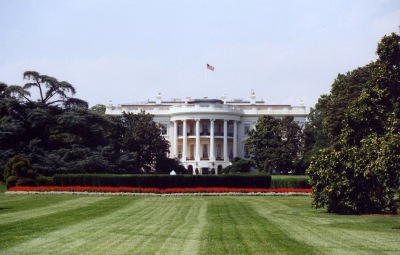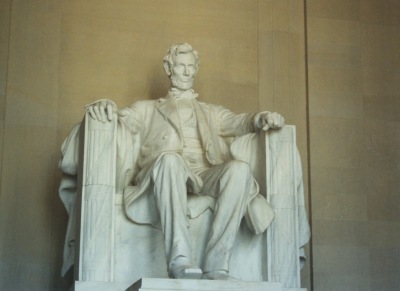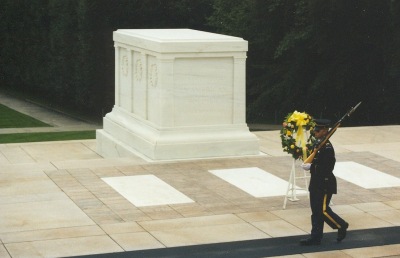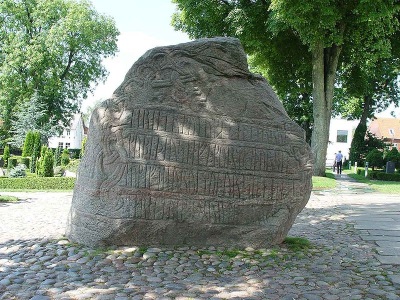- haraltr : kunukR : baş : kaurua
- kubl : şausi : aft : kurm faşur sin
- auk aft : şąurui : muşur : sina : sa
- haraltr (:) ias : sąR * uan * tanmaurk
- ala * auk * nuruiak
- * auk * t(a)ni (* karşi *) kristną
Why can't Americans spell?
Washington DC has been the capital of
the United States since 1800 and the first president who lived in the White House
was John Adams, who hated the city as well as the house. He considered the city
to be a mosquito infested swamp," and he was problably right. The town was
certainly built in a swamp on the banks of the Potomac River. DC is also known
as the District of Columbia, to show that the city is not subject to any state,
although the land it is on, was mostly donated by Maryland. Originally also
Virginia donated land to the city, but this area (West Potomac), was returned to
Virginia in 1846. Before Washington became the capital, New York and Philadelphia
served as the U.S. capital, but in 1800 the government and the
president was moved to the newly built city. Unfortunately, there were not many others who
moved along and the town was for many years a place of deserted streets covered
in mud
and with only a very few buildings.
In
1814 British troops captured the town and burned the Capitol and the White
House, and after the war against England, the city had to be rebuild almost
from scratch.
Finally
in 1871 most streets were paved and equipped with drainage and street lighting.
This period also brought the parks, etc., but in return the city went
bankrupt.
Since then the city has
evolved for the better, and now we were going to see it for the first time. Like
all big cities also Washington is best seen at ground level and at a slow pace -
meaning walking, so it was also our plan. We started, however by taking a
shuttle bus from the hotel to the nearest subway station. Near the subway station
we found a little joint where we ate breakfast. The owners were Vietnamese, and
the food was better than their English. We didn't exactly got what we thought we
had ordered, but what we did get whas excellent.
 After breakfast we walked down the stairs to the subway
station. Here we bought four day-tickets and took the subway to the Capitol South
station, the subway station, located most centrally in the city. From there we
walked (ie, Dorte, kids and I - the others were out for themselves), up to
Capitol, as Dorte wanted to take a guided tour. However, there was a sign
telling us that there were approx. 2 ½ hour waiting time, so although Dorte
would have waited, she was outnumbered. So we went for a walk instead.
After breakfast we walked down the stairs to the subway
station. Here we bought four day-tickets and took the subway to the Capitol South
station, the subway station, located most centrally in the city. From there we
walked (ie, Dorte, kids and I - the others were out for themselves), up to
Capitol, as Dorte wanted to take a guided tour. However, there was a sign
telling us that there were approx. 2 ½ hour waiting time, so although Dorte
would have waited, she was outnumbered. So we went for a walk instead.
Many of the city's famous sights are concentrated around
the Capitol and the Mall. Walking from the station, we had already passed the Library
of Congress, the world's largest library with more than 120 million catalog
numbers. Right next to the LOC, is the building which houses the Supreme Court
of the United States. This building and the staircase in front, has appeared in
many movies. Since we could not get into the Capitol, we simply viewed it from
the outside. When we had seen - and photographed enough, we chose to walk down
Pennsylvania Avenue. Here we passed some departments and also the U.S. National
Archives and Records Administration. Here you will find, among other things, the
original Declaration of Independence and the original version of the U.S.
Constitution. And besides, more than 3 billion other documents. You can visit
the archive, but Tina would rather visit the building on the other side of the
street, the J. Edgar Hoover Building, the FBI's headquarters. Again there was a
queue, but only for approximately 70 minutes and when both Dorte and Tina voted
for, that was it. Personally I do not think that the tour was anything special. It lasted 45 minutes, and we mostly saw posters, which told of the
FBI. We also heard about the fantastic training that the FBI gives its agents.
16 weeks the course last (ok, most students come with a university degree), so I wondered
a little at how good a Danish police training could be. In Denmark an ordinary
policeman spends three years of training at the Police Academy before being
unleashed on the population.
I
enjoyed
hearing that the FBI's main job is to fight all the evil people from foreign
countries, that even in peacetime uses many resources to spy on the U.S. to
intercept and steal government secrets, military and civil technology
achievements and such. I could not help but laugh - so a number of the tour
guests stared fiercely at me and I got an almost irresistible urge to ask what
the U.S. used institutions like the CIA, the NSA and other similar institutions
for in peacetime. But I fought the urge. After the tour there was an option that
we could also be allowed to attend a shooting using sharploaded weapons -
and then we waited another 20 minutes for that to begin. A female agent
demonstrated shooting with various hand guns, and Tina thought that it was
very interesting. For my part I've shot a lot with both pistol and submachine
gun in my 12 years in the Royal Danish Navy, so I didn't get too excited.
When the visit to the FBI was over, we went further down
Pennsylvania Avenue to No. 1600. This was the home of our host in the U.S., at the
time Bill Clinton. For some reason we were not invited to afternoon tea,
even if we came from the other side of the world, so we chose to look at the White House
from the outside.
 Instead of visiting the
president
we went back to "The Mall". Along this park are various memorials to
different events and people. It is also where you find the museums belonging to
the Smithsonian Institute (which, incidentally, was founded by an Englishman).
After a visit at the Vietnam Veterans Memorial,
we walked down to the Lincoln Memorial. This copy of a
Greek temple is the memorial to President Abraham Lincoln. Around the temple are
36 pillars representing the states of America when Lincoln was president from
1861 to 1865. Inside the "temple" is a 20 feet tall statue of the president, and
on the walls you can see various excerpts from presidential speeches.
Instead of visiting the
president
we went back to "The Mall". Along this park are various memorials to
different events and people. It is also where you find the museums belonging to
the Smithsonian Institute (which, incidentally, was founded by an Englishman).
After a visit at the Vietnam Veterans Memorial,
we walked down to the Lincoln Memorial. This copy of a
Greek temple is the memorial to President Abraham Lincoln. Around the temple are
36 pillars representing the states of America when Lincoln was president from
1861 to 1865. Inside the "temple" is a 20 feet tall statue of the president, and
on the walls you can see various excerpts from presidential speeches.
On the
stairs in front of the monument the kids went on strike. They simply refused to
look at any more monuments, as their legs were tired and their feet were sore, so we
decided to go to the nearest subway station, located approx. off the middle of
the park. But not before we had taken a picture of Mr. Lincoln, and Tim took a
picture of us in front of the statue. Unfortunately old Abe was "beheaded" in the
picture, but it is still in our album from the trip.
On the way to the subway we passed the Korean War
Veterans Memorial. The monument is composed of several parts. First, a
triangle intersecting a circle. Inside the triangle are 19 statues of soldiers,
made of stainless steel. The group represents a squad on patrol, and it consists
of 15 Army soldiers, two members of the U.S. Marine Corps, a sanitation man from
the Navy and 1 oberserver from the Air Force. On one side of the triangle is
a 50 yard long wall of black granite with sandblasted images of equipment, soldiers
and other people who were involved in the war. In the middle of the circle is a
circular pond. Around the pond is a low wall of granite, where the number of
dead, wounded, prisoners of war and missing are engraved. North of the triangle
with the statues, is also a low wall. Here you find the names of all 22 nations that
contributed to the UN Force in Korea. Tina was very pleased when she saw Denmark so she and Dorte
had to have their pictures taken standing by the wall.
We took the subway and shuttle bus back to the hotel to rest until it was time for
dinner. As one part of the family still had stomach problems, and our kids
were so tired from walking, that they could not eat anything, Dorte and I went
to a supermarket, and bought some fruit, bread and sliced ham and cheese etc.,
which we took back to the hotel for dinner.
The next day was spent in Washington DC as well. Once again we
bought a day-ticket for the subway. This time Arlington Cemetery was our goal. But first
a delicious breakfast of the bread, cheese and cold cuts, we
had bought the day before. The intention was that after Arlington, we would
visit at least one museum. Else and Carl would also like to go to Arlington, so
they joined us. We took the subway to Arlington and then walked to the cemetery.
It was possible to go on a guided tour in an airconditioned bus around the
cemetery, but when we arrived the tours were suspended due to a funeral.
Else, Carl and Tim, who still had sore feet after yesterday's hike, decided
to wait 45 minutes for the next bus while Dorte, Tina and I chose to walk around instead.
The cemetery was founded during the Civil War, when the
Union in 1864 lacked a burial site for their many dead soldiers.
Quarter Master General of the Union army Maj. Gen. Montgomery C. Meigs, who hated
the south, suggested that the Union should confiscate the 200 acres of land in
Arlington which belonged to Mary Anna Custis Lee, greatgranddaughter of George
Washington's wife and now married to Confederate general Robert E. Lee. Custis
Mansion or Arlington House, which it was also called, was located in Arlington just
on the other side of the Potomac River from Washington. To justify the
confiscation of land, he claimed that Lee had not paid taxes to the Union. Later,
Lee's heirs brought on an lawsuit against the government and the Supreme Court ruled
that the confiscation was illegal and returned the land to Lees oldest son. He
sold the part of the land, where the cemetery was situated to the government for $ 150,000.
At end of the Civil War more than 16,000 soldiers were buried at Arlington. Later, the area has been expanded
so it now covers about
600 acres and around 300,000 people are buried in the cemetery, which is
America's main national cemetery. Arlington House itself now serves as a museum
for
Robert E. Lee.
Among the most famous people who are buried in the cemetery,
are probably the Kennedy brothers, so we visited their tombs first. On John F.
Kennedy's grave burns an eternal flame. Besides Kennedy, his wife, Jacqueline
Bouvier Kennedy Onassis, and two of their children, an unnamed, stillborn
daughter (1956) and a son Patrick, who died two days old in 1963 is buried at
the site. Although Kennedy
died when I was ten and I'm not one of those who remember exactly what
they did when they got notice of his death, it nonetheless gives a strange feeling standing
by his grave. After the visit here, we walked to Robert Kennedy's grave
and saw that as well. This was not as emotional as being at the tomb of his
brother, and
I think that Dorte had the same feeling as I, while Tina most of all
wanted to go on with the tour.
So we went up to Arlington House, which unfortunately was closed due to
renovations, but we could enjoy the view of Washington from the hill top. Lee lived
nicely when he lived here.
From Arlington House, we continued down to the Tomb of
the Unknown. Along the way we met a huge funeral procession. In front was a car with some plainclothes guards
that waved people away from the
road. 50 yards behind the car came a military band that played funeral music. After the
band followed an escort platoon from the 3rd U.S. Infantry Regiment, which
is responsible for the ceremonial activities at Arlington. 50 yards behind the guard
followed a
lone navy chaplain, and another 50 yards behind him followed the the coffin covered
in Stars and Stripes, placed on limbers
and caissons pulled by 6 horses. This was followed
by a riderless horse with a pair of boots reversed in the stirrups, and carrying what
probably was the deceased's sabre and rifle. The horse was lead by a major. Afterwards came
a group of around 200 people on foot, and after that around 50
large limousines. Finally another car with plainclothes security guards. It
was all very impressive, and while the procession passed, we stood and looked at
the procession with due respect. The ceremonial indicated a full honors military funeral, but
we never found out who was laid to rest that day.
 At
the Tomb of the Unknown, we witnessed the changing of the guard. The monument
are guarded around the clock, by members of The
3rd U.S. Infantry Regiment (The Old Guard ). This regiment, which is the oldest in the U.S. Army,
was formed way back in
1784, and also serves as the President's guard and military escort. Changing
of the Guard at the tomb takes place every half hour. Many Danish people will
probably think that the ceremony is slightly exaggerated, but for an old naval
officer like myself, it seems to be OK, although I can not quite imagine something
similar in Denmark.
At
the Tomb of the Unknown, we witnessed the changing of the guard. The monument
are guarded around the clock, by members of The
3rd U.S. Infantry Regiment (The Old Guard ). This regiment, which is the oldest in the U.S. Army,
was formed way back in
1784, and also serves as the President's guard and military escort. Changing
of the Guard at the tomb takes place every half hour. Many Danish people will
probably think that the ceremony is slightly exaggerated, but for an old naval
officer like myself, it seems to be OK, although I can not quite imagine something
similar in Denmark.
After the visit at the Tomb of the Unknown, we walked around the cemetery
and looked at several graves, both known and unknown people, among others, Pierre
L'Enfant, Washington's town planner and one of the few foreigners who are buried in
Arlington. He was born in France, but he had become a U.S. citizen. Another foreigner
is Field Marshal Sir John Dill, who was an English liaison officer during World
War 2. After a while we were getting tired so we sat on a
bench at the memorial for the astronauts killed when space shuttle Challenger
exploded. Here we were contacted by one of the cemetery guards. Not because we
had done something wrong, but she was very impressed by Tinas hairdo, and would like
to know where and how she had it made. Tina told the female guard that it was
made by her
hairdresser in Denmark.
After the visit to Arlington, we considered a
visit to the Pentagon, but as it was getting late and we still hadn't visited any
museum, we skipped it. Tim, Else and Carl had already returned to the hotel, so Dorte, Tina
and I just walked to the subway station and took a train back to
the center of town. Here we got a bite to eat at the Old Post Office Pavilion. From there we went down to the Museum of Natural History, which
was our chosen museum of the afternoon. On our way we passed a very ominous building. Dark and gloomy
it looked, and it is indeed the headquarters of a public authority that most
people fear. The authority, which eventually made sure that
Al "Scarface" Capone was imprisoned. Although it has a three letter
abbreviation, it is neither the FBI, CIA or any other intelligence service. The
abbreviation IRS simply stands for Internal Revenue Service, or in Danish The Tax
Authorities.
The Museum of Natural History is large, very large, so we had to concentrate on
a few things. It was a part of the ground floor where we saw skeletons of giant
dinosaurs such as Tyrannosaurus Rex, Velociraptor, Diplodochus, Stegosaurus,
Protoceratops, Triceratops, Pterodactyl and whatever these monsters are called. But we also
saw some
extinct mammals as mammoth and aurochs. I took a picture of Dorte and Tina in front of a skeleton.
Later when I wrote my vacation diary, I christened the picture "The
Three Mastodonts" which didn't exactly made me popular in the female part
of the family. On our way out the
museum Tina suddenly caught sight of a painted copy of the large "Jelling
Stone" made of papier
mâché. For those of you that don't know, the "Jelling Stone" is a large rune
stone, placed outside the church of the small
town Jelling in Denmark. The stone have a rune inscription:
which translated from ancient Norse means something like:
 "King
Harald ordered this monument made in memory of Gorm, his father, and in memory
of Thyra, his mother; that Harald who won for himself all of Denmark and Norway
and made the Danes Christian."
"King
Harald ordered this monument made in memory of Gorm, his father, and in memory
of Thyra, his mother; that Harald who won for himself all of Denmark and Norway
and made the Danes Christian."
The picture to the left, shows the real stone in Jelling, Denmark. Harald was King of Denmark from around 945 to 986 AD and as this is the first time, it is mentioned that the danes had become christians, the stone is known as "The Danes' Certificate of Baptism".
It turned out that the
stone was an announcement of a Viking exhibition, and we decided to visit it,
before we left the museum. Personally, I found it interesting, while Tina was
very annoyed because the exhibition signs told that the Vikings came from Scandinavia, instead
of telling that they came from Denmark! She was also very angry that most of the
exhibits came from Norway and Sweden and the only Danish stuff came from Haithabu
(Hedeby) and
Ripa (Ribe). And worst of all: They claimed that these two cities were in Jutland!! Tina was very angry
because Americans could not spell a word as simple as "Jylland" (the Danish
spelling). Even when we got back to the
hotel, and she had repeated her furious thoughts to Tim, she was not inclined to
listen to his arguments that we also says "Tyskland", not Deutschland
(Germany). The two
things had
absolutely nothing to do with each other, she claimed.
We were quite tired after today's
excesses, and did not want to go for a long walk to get dinner. We therefore
decided to go to an Italian restaurant which was just across the street from the hotel. The
kids didn't want to eat anything, and half of the family still suffered from diarrhoea, so
in the end only Else, Carl, Dorte and I went. And just as well.
The four of us shared two pizzas
and half bottle of red wine and got a bill of DKK 475 ($ 65), by far the most expensive meal we had in the US at that time. In Denmark we could have had the
same for about 175 DKK ($ 20). This meal concluded our first visit to the capital
of the United States.